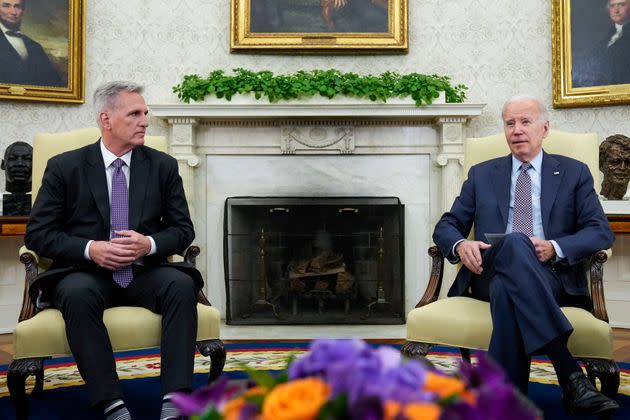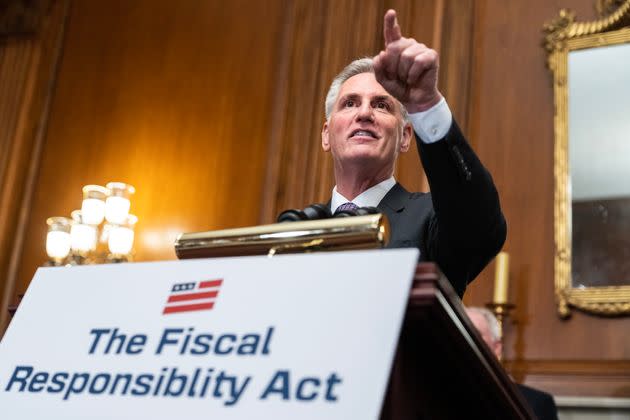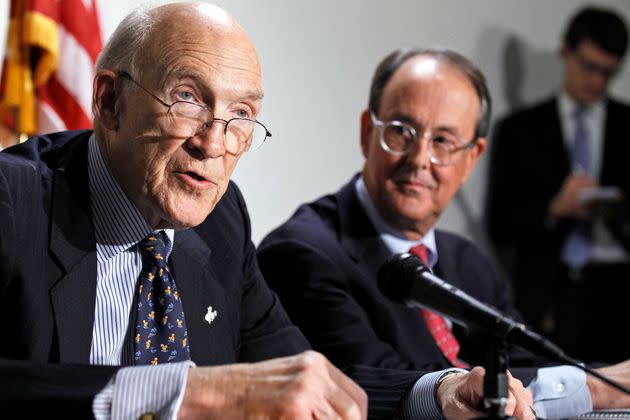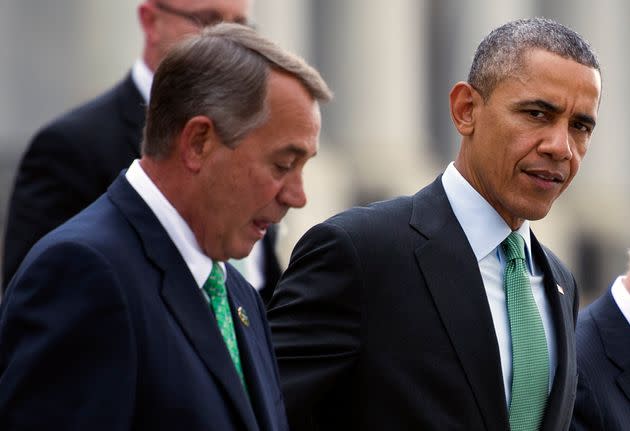How DC Learned To Stop Worrying And Love The Deficit
- Oops!Something went wrong.Please try again later.
- Oops!Something went wrong.Please try again later.
- Oops!Something went wrong.Please try again later.
- Oops!Something went wrong.Please try again later.

President Joe Biden (right) meets with House Speaker Kevin McCarthy to discuss the debt limit in the Oval Office of the White House on May 22.
As lawmakers in the U.S. House debated a big budget bill that would slash hundreds of billions of dollars from the deficit, they desperately implored their colleagues to think about the future.
“Our decision will determine whether we finally take steps to reduce these deficits, and stop piling increasing amounts of debt on our children and grandchildren — or whether we continue to run massive deficits and allow the national debt to continue to soar,” a Democrat from California said.
“When it comes to spending cuts, it only promises cuts some place down the road at some far off tomorrow — a tomorrow that probably will never come,” a Republican from Kentucky pleaded.
But they weren’t talking about the new bipartisan debt limit deal that passed Congress a few weeks ago. Those words were said almost 30 years ago, on Aug. 5, 1993, by Rep. Anthony Beilenson of California and Rep. Jim Bunning of Kentucky.
And they were about President Bill Clinton’s first big budget bill, which also raised the debt ceiling to the then-eye-watering sum of $4.9 trillion. Today, the debt is more than six times greater, standing around $32 trillion.

McCarthy conducts a news conference after the House passed the Fiscal Responsibility Act, the formal name for the debt limit deal approved just weeks ago.
Washington’s allegedly been at war with the budget deficit for decades. If that war is still ongoing, the latest budget deal, which will cut $1.5 trillion in federal spending over the next 11 years in exchange for suspending the debt ceiling through the end of President Joe Biden’s first term, is a sign the red ink is winning.
But it’s also a sign Congress may be reaching a bipartisan conclusion that long-term debt and deficits are not the impediment to economic growth long feared, and is embarking on a huge, if unplanned, fiscal experiment.
“It’s been a long history of saying ‘tipping points, tipping points, tipping points.’ And obviously we haven’t hit it,” said Dean Baker, co-founder of the liberal Center for Economic and Policy Research. “I think there’s an argument we should be looking to lower the deficit but, again, it’s very far from a crisis.”
Congress’ nonpartisan bookkeepers say the deal would not change the trajectory of the national debt. Instead of rising to 119% of the size of the economy by 2033, the debt-to-GDP percentage would now rise to only 115% and to $50.1 trillion.
It’s been a long history of saying ‘tipping points, tipping points, tipping points.’ And obviously we haven’t hit it.Dean Baker, co-founder of the Center for Economic and Policy Research
Another sign of red ink’s victory? How quickly Congress is looking to spend even more cash.
Only weeks after the deal’s passage, defense hawks have said they want to boost military spending above what was in the deal. And the GOP-controlled House’s tax-writing Ways and Means Committee approved three bills Tuesday to temporarily extend some of the 2017 tax cuts. If the new bills’ provisions were made permanent, they could wipe out almost all of the deficit reduction in the debt limit deal.
House Speaker Kevin McCarthy (R-Calif.) acknowledged last week that the deal was just “the beginning of turning the ship.”
McCarthy insisted the press should focus on the Congressional Budget Office projecting a 4 percentage-point drop in the debt-to-GDP measure, a proxy for debt burden: “You could reframe this whole question and say the CBO just came back and reaffirmed what you wanted to achieve with only having the House. That’s a positive, right?”
It wasn’t supposed to be this way.

Former Sen. Alan Simpson (left) and former White House Chief of Staff Erskine Bowles take part in a news conference in 2010. The pair led a high-profile deficit reduction commission that year often referred to as Simpson-Bowles.
After more than a decade of bipartisan benign neglect toward the deficit, House Republicans went into this year’s debt ceiling confrontation eager to say they changed the trajectory of spending and deficits in Washington. And the House GOP’s opening bid this year reflected that, with savings of close to $4.8 trillion.
Republican leaders, eager to convince their voters and House members of the debt limit deal’s small-government bona fides, have noted the deal is the biggest deficit cut since 2011, which was negotiated by President Barack Obama and House Speaker John Boehner (R-Ohio) at the height of Washington’s focus on the deficit. It is nonetheless small potatoes when compared to the $20.33 trillion in deficits the government is set to run over the next 10 years.
And that $20.33 trillion figure is decidedly optimistic. The CBO assumes the individual income tax cuts of the 2017 GOP tax law expire as planned in 2025, which would amount to a tax hike on most Americans. Keeping the tax cuts would add another $2.8 trillion to the 10-year deficit.
And, unlike the 2011 debt limit deal, the deficit reduction in the new deal would only pay for about half of the amount of new debt expected to be incurred while the debt limit is suspended.
You could reframe this whole question and say the CBO just came back and reaffirmed what you wanted to achieve with only having the House. That’s a positive, right?House Speaker Kevin McCarthy (R-Calif.)
Washington Post economics columnist Catherine Rampell summed up the deal’s underwhelming nature by calling it “probably fine.”
“Certainly it’s preferable to some alternatives many of us feared. On the other hand: What was the point of all this drama, exactly?”
Barring a financial crisis, the deal sets up a possible inflection point for fiscal policy in 2025, when some the 2017 tax cuts expire as does an expansion of Obamacare tax credits. If Congress doesn’t act then, it might not do so until 2033, when the CBO says Social Security will be unable to pay full benefits.
The situation is quite a turnabout from about a decade ago.
From 2010 to 2012, budget experts craved a “grand bargain,” in which Republicans would trade the expiring tax cuts passed by George W. Bush for cuts to entitlement programs like Social Security and Medicare. Both Obama and Boehner thought it could be a legacy-making deal and prioritized deficit reduction above every other economic goal.
At the time, the debate was widely informed by a 2010 paper by economists Carmen Reinhart and Kenneth Rogoff that claimed public debt above 90% of GDP hindered economic growth.
Three high-profile efforts — a presidential commission referred to as Simpson-Bowles, a negotiation between Obama and Boehner and finally a congressional “super committee” — all came up short.

President Barack Obama and House Speaker John Boehner (R-Ohio) walk on Capitol Hill in Washington in 2015. The pair attempted to negotiate a sweeping budget deal in 2011. They ultimately failed.
For the next several years, budget dealmaking was limited to biennial mini-bargains, with the most ambitious attempting to simply pay for extra spending allowed by busting the budget caps set in the 2011 deal.
At the same time, the Reinhart and Rogoff paper lost most of its credibility after its authors admitted data errors and it came under close scrutiny by other researchers.
On Capitol Hill, the number of fiscally conservative Democrats known as Blue Dogs dwindled, while Donald Trump-led Republicans prioritized tax cuts as a higher priority over deficits, pushing through a massive set of individual and business tax cuts Republicans had long dreamed of in 2017. The cuts were projected to add about $2 trillion to the debt.
And in 2021, coming into office during the COVID-19 pandemic, Biden passed his $1.8 trillion American Rescue Plan, the first in a trio of major bills including an infrastructure bill and the Inflation Reduction Act. Unlike Obama, his former boss, Biden came into office with expectations of enacting an FDR-style New Deal agenda.
Doug Holtz-Eakin, a president of the conservative American Action Forum and a former CBO director, said the new debt deal was never expected to be a big deficit-fighting one, with Biden successfully baiting the GOP into taking entitlement cuts off the table and the GOP insisting no taxes could be raised nor defense spending cut.
“Nobody’s talking about grand bargains because we haven’t talked about the need to do anything serious for a decade,” he said.
Nobody’s talking about grand bargains because we haven’t talked about the need to do anything serious for a decade.Doug Holtz-Eakin, president of the American Action Forum
One ratings firm, Fitch Ratings, kept the U.S. debt on watch even after the deal, signaling it could still downgrade it from the current pristine status soon. Fitch cited brinkmanship and that “failure to tackle fiscal challenges from growing mandatory spending has led to rising fiscal deficits and debt burden.”
On a similar note, Larry Summers, the Clinton-era treasury secretary with a seeming love of pooh-poohing the dreams of liberals, said in a speech at the Peterson Institute for International Economics that the deal was a mixed bag overall.
“What it does not do is change by very much the long-run fiscal posture of the United States,” he warned, estimating the annual deficit in 2033 won’t be the 7% of GDP currently projected but likely closer to 11%, a figure near pandemic-era deficits and higher than at the height of the global financial crisis.
“I don’t think the magnitude of this potential challenge is greatly appreciated,” he said.
Baker insists concerns about hitting a debt wall are overblown. Japan’s debt is about two and a half times the size of its economy and it pays lower interest rates than the U.S. does, he noted.
I don’t think the magnitude of this potential challenge is greatly appreciated.Former Treasury Secretary Larry Summers
McCarthy, meanwhile, is fending off blowback from conservatives disappointed in the debt bargain. The House Freedom Caucus briefly hijacked the floor of the chamber this month in protest of the deal.
Part of his answer: another bipartisan budget commission.
That, too, would be a blast from the past: To get his vote for the 1993 budget plan in the Senate, Nebraska Democrat Bob Kerrey extracted from Clinton the creation of a commission, co-chaired with Senate Republican John Danforth, to look at entitlements and tax reform.
As the Social Security Administration dryly notes on its website:, “Ultimately, the Commission failed to achieve consensus and went out of business without issuing any recommendations.”
